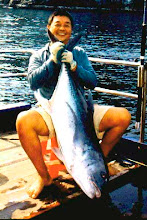 |
| Haruan Haruan Everywhere was published in the April 2000 issue of Rod and Line Fishing Magazine. |
Many a riverine kampung folks had their Hari Raya celebrations dampened by the downpour, which was quite unexpected. As usual with such weather, low-lying areas were denuded by floodwater. The Kampung Gajah area was no exception. A few sections of the road leading to Teluk Intan were immersed in fast flowing water. After a harrowing drive through these stretches, my friends and I managed to reach the Leaning Tower Town (to shop for outboard engine). The whole time we were sweating in our under wears as any mistakes made would result in us being swept off to the side of the road, which by now had turned into a fast flowing river.
While sweating and squirming, my mind was already thinking of the miles and miles of flat land immersed in water on both sides. You see, the Tumboh River, which meanders through the Pengkalen Nibung area, could not handle the huge volume of water being released by Heaven. As the Kinta River was also swollen due to the numerous tributaries draining into it at the Lower Perak area, the water got no where to go except to find its own level. As the flatland was flooding, the many tomans, haruans and other denizens that had being eking out a living in overcrowded shrinking patches of marshy land were suddenly being granted excess to the other areas. Imagine a whole bunch of half-starving penitentiary inmates being released into a hall filled with delicious food? Now you know what I was thinking.
 |
| Foo holding up his catch. |
Those who grabbed the opportunity that day would get the shiver when served with any haruan dish for a long time to come. Everywhere you look you could see anglers struggling, landing or counting their catches. As for me, I got to squirm for two more days before Foo and I could muster some free time to go. Tumboh River, with its source at the Kledang Range, flows through this area. Due to the rotting vegetation and peat soil, the water is dark in colour, hence the name 'Hark Suei Hor" (Black Water River). A lot of different specie of fish can be found here, but of late due to the deepening and widening work in progress, the fishing here was already kaput.
Foo and I went our separate ways to cast after reaching the flooded area. The bites were not encouraging, as the water had subsided quite a lot. The hot sun at 3.30p.m. did contribute to it too. By 5.00p.m. cheroots (small haruans) were being landed regularly. Foo was tied to a big fellow that headed straight for some submerged shrubs. That fish would think ten times before chomping on a frog again. Could be a toman by the way it fought. My hunting ground was a small break in the bund on which I was standing. Water was flowing from one side of the bund to the other. Small fish were seen darting and rushing in the current. From the swirls on both sides, I could tell that there were predators doing their work. Let's say 'great minds think alike'.
 |
| This young lad was very upset because I released my catches. Look how the setting sun cast its beautiful yellow rays everywhere. |
I began to cast here and immediately induced a strike. All in all I caught ten haruans, all of which had not qualify for their identity cards yet! While releasing one, I noticed a young local lad speaking to Foo and at the same time gesturing with his forefinger pointing to his head in a circular motion. I knew the meaning of his very uncomplimentary gesture, but I didn't know why he was directing it at me. Later I found out from Foo that the lad was very upset that I released all my catches. In order to pacify him, I gave him my two latest catches with a short lecture on conservation thrown in. When I left him, he was smiling, but I could bet my bottom dollar that it was not because of the fish that I gave him.
 |
| Two local anglers, Abdul Rahim and Mohd Husni proudly showing off their catches. There were plenty more in their keep-net. |
By Sunday, I could not contain my itch anymore. My better half was dragged along as company because the other kakis were busy. (My wife likes fishing, but hates the sun). Timing our journey, we reached our destination around 4.00p.m. Almost immediately, I was into cheroots again. There is always a limit to everything including fishing. A bit disappointed, my wife and I went over to watch some local ladies fishing for puyus. These very obliging delicacies (puyus of course) were in plentiful supple. The lady we were watching used grasshoppers as baits. (She was geli of worms).
Once in a while her rod tip was dipped and stirred in the water. Out of curiosity I enquired the reason for the ritual. "Oh, to attract the puyus," was her reply. And it worked!
 |
| A local lady fishing for puyus. Here she was just dipping her rod tip and stirring the water to attract fish. |
All this while my attention was occasionally distracted by the sound of a mother hen clucking to her chicks. Looking around I just could not place where the brood was. This went on for more than half an hour before I finally pinpointed the source of the clucking. Another lady fishing nearby was the 'clucking mother hen'. "To attract fish ah?" I asked. She answered in the affirmative. Well, talk about experience. In all my years of fishing this was the first time I was seeing this. In fishing you just can never stop learning.
By now a number of locals were out casting for haruans. Rushing over to the hottest hitting spot I joined in the fray. Fish after fish were taken at every other cast. I should have kicked myself for bypassing this area earlier as the water here was only 30cm deep. After keeping two respectable size haruans as a reward for my wife (she loves haruan porridge) I went over to talk to the locals. Wow! They were having a real good time. It had being ages since I last saw such frenzy feeding from haruans. The usual scenario now is you got to cast until your arms dislocate from your shoulder before getting a strike. In the end I managed to get a few shot of the locals in action before we were forced to run for the car as the sky opened up again. Driving back, I was of two minds as I just love this type of fishing during the rainy seasons, but I prayed that the riverine folks do not have to suffer the rages of the floodwater for it.
Looking back, all the haruans caught those two days were quite small. Most were cheroots. None were anywhere near those giants that we used to catch regularly in the 60s and 70s. The protective nature of the snakeheads on the whole contributed to their downfall. Once they breed they are in trouble, as it is very easy to locate the parents with their babies coming up for air. And unless they have being hooked and escaped before, they never failed to strike, maybe out of parental instinct. I am always for close season to allow the fish to breed, multiply and grow.
